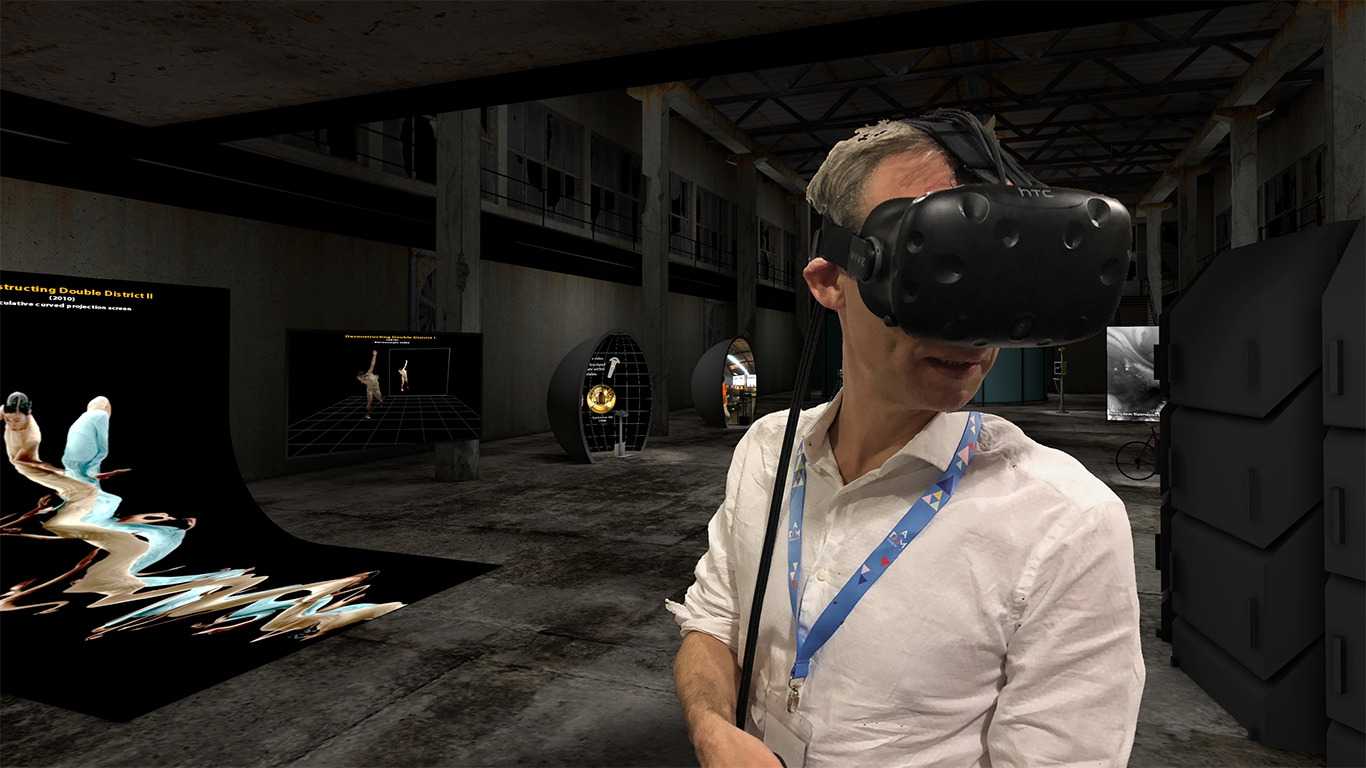The (Virtual) Reality Museum of Immersive Experiences (PC)
The (Virtual) Reality Museum of Immersive Experiences is a very special kind of museum. It exhibits projects originally designed for large-scale immersive environments in a simulation that is true to the physical manifestation of these systems.These systems include 360 degree panoramic and hemispherical projection screens, stereoscopic 3D multi-view installations and a number of spatial and experimental video inhalations. Situated in a large derelict warehouse, the 3D museum is freely navigable and the many exhibits can be explored interactively. A wide variety of content is accessible, ranging from the arts to research project outcomes. There are even demonstrations of VR projects within this virtual museum.
Immersive display and interaction environments and systems have been utilised in simulation, visualisation, entertainment, the arts and museological context for a long time before VR made its resurgence only a few years back. Applications and experiences created for a specific physical immersive platform rely on the complex and costly technical infrastructure they were originally designed for. Descriptions and video documentation only go so far in illustrating an immersive experience. The embodied aspect, the emotional engagement and the dimensional extend, central to immersion, is mostly lost in translation. The idea behind this project is to provide a framework to showcase and for the conservation and preservation of immersive experiences and architectures outside specialised facilities and labs.
This simulation gives a good sense of how an immersive experiences functions in regards to scale, field-of-view, peripheral vision, audience viewing position and perspective. It is able to preserve what an experience felt like.
ACKNOWLEDGMENTS
SYSTEMS: EPICylinder; Design: S. Kenderdine, J. Shaw; UNSW Expanded Perception and Interaction Centre. AVIE Advanced Visualisation and Interaction Environment and AVIE-SC; Design: J. Shaw with D. Del Favero, A. Harjono, V. Kuchelmeister, M. McGinity; UNSW iCinema Centre for Interactive Cinema Research. RE-ACTOR; Design: S. Kenderdine, J. Shaw with P. Bourke. iDome; Design: P. Bourke, V. Kuchelmeister, J. Shaw; UNSW iCinema. Turntable/Placeworld; Design: J. Shaw, adapted as Turntable by V. Kuchelmeister. ZKM Karlsruhe / UNSW Art & Design. Panorama Screen; Design: J. Shaw with B. Lintermann; ZKM Centre for Art and Media Karlsruhe.
APPLICATIONS: Veloscape (2014); V.Kuchelmeister, L.Fisher, J.Bennett; UNSW Art & Design. City Jam (2007) in AVIE; V. Kuchelmeister; UNSW iCinema. BackOBourke (2009) in iDome; V. Kuchelmeister; UNSW iCinema. Juxtaposition (2011) in Turntable/Placeworld; V. Kuchelmeister; UNSW A&D. Fragmentation (2012) in RE-ACTOR; R. Lepage; Adaptation, by R. Castelli and V. Kuchelmeister; UNSW iCinema, Epidemic. Monsoon (2012) in AVIE; V. Kuchelmeister; UNSW iCinema. Naguar India 360 (2007) in iDome; S. Kenderdine, V. Kuchelmeister, J. Shaw. Catlin Seaview (2014) in iDome; V. Kuchelmeister, R. Vevers; UNSW A&D. Juxtaposition (2011) in ZKM Panorama Screen; V. Kuchelmeister; UNSW A&D. Double District (2009) in ReACTOR; S. Teshigawara developed with V. Kuchelmeister; UNSW iCinema, Epidemic. Parragirls Past Present (2017) in EpiCylinder; A. Davies, B. Djuric, L. Hibberd, V. Kuchelmeister, J. McNally; UNSW A&D. Hawkesbury Journey (2006); V. Kuchelmeister; UNSW iCinema. Conversations @ the Studio (2005) in iDome; J. Shaw, D. Del Favero, N. Brown, V. Kuchelmeister, N. Papastergiadis, S. McQuire, A. Arthurs, S. Kenderdine, K. Sumption, G. Cochrane; UNSW iCinema. iCasts (2008-11); J. Shaw, D. Del Favero; UNSW iCinema. Deconstructing Double District (2010); V. Kuchelmeister, based on Double District (2009) by S. Teshigawara; UNSW A&D. Zeitraum (2012) in AVIE-SC; V. Kuchelmeister; UNSW A&D.
Desarrolladores
Volker KuchelmeisterEnlaces
Viveport
Fecha de salida
Diciembre 6, 2018
SOs compatibles
HMDs compatibles
Forma de juego
Comentarios (0)







